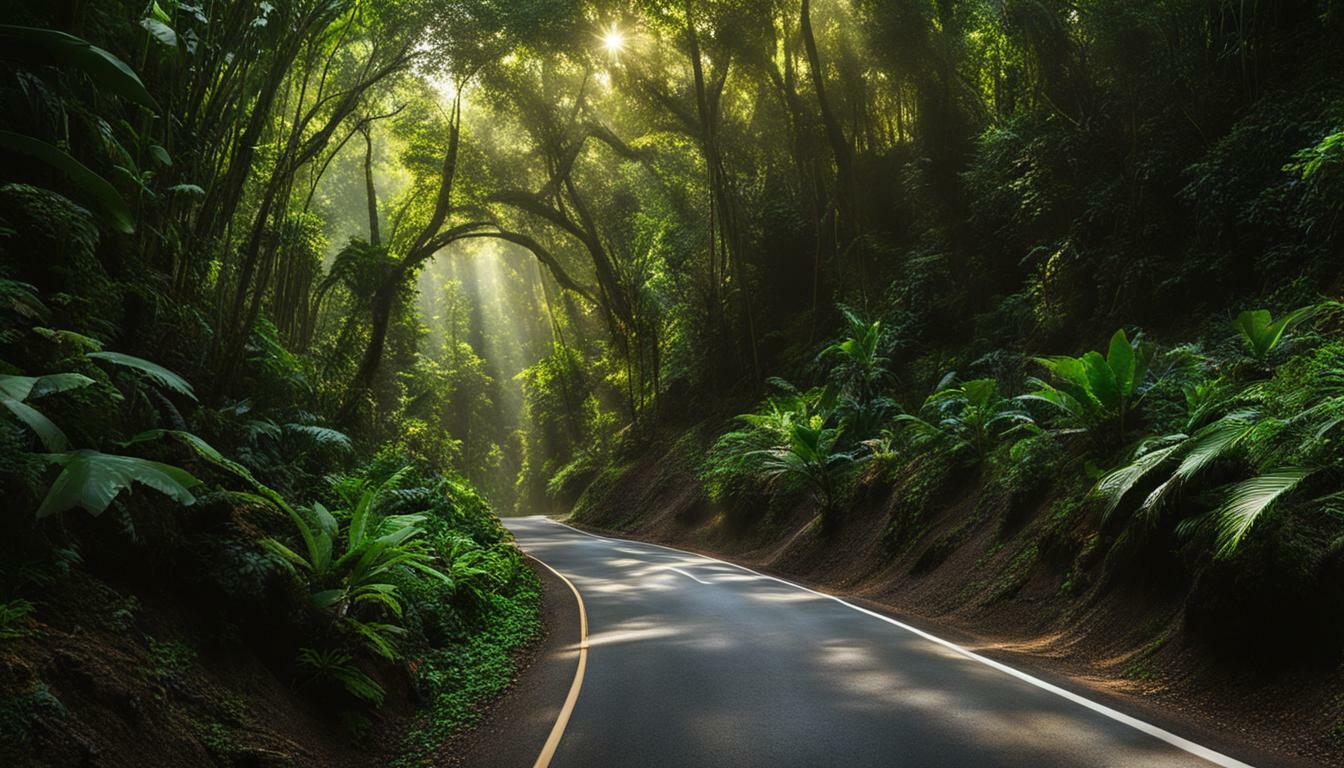Driving in Costa Rica
Experience the thrill of driving in Costa Rica! Driving in Costa Rica can be a bit intimidating, especially for first-time visitors. However, with some knowledge and experience, it can be a great way to explore the country.
In order to drive in Costa Rica, all you need is a valid driver's license from your home country, and there is no requirement for an international driver's license. The rules of the road in Costa Rica are similar to those in other countries, with speed limits and seatbelt requirements. However, it's important to note that enforcement of these rules can be lax in some areas.
The road conditions in Costa Rica can vary greatly, from well-paved highways to pothole-ridden dirt roads. It's advisable to research in advance if a 4×4 vehicle is necessary for the specific places you plan to visit. Signs in Costa Rica are often lacking, particularly in rural areas and beach towns, so it's recommended to use a GPS or map program on your phone. During the rainy season, there can be washouts and landslides on certain roads, so it's important to check the current conditions before setting out.
When driving in Costa Rica, it's important to be aware of pedestrians, bicycles, motorcycles, and animals on the road. Motorcycles and dirt bikes are popular modes of transportation, and it's important to be cautious when passing them. Costa Rican drivers are known for unsafe passing, so it's important to drive defensively and be prepared for unexpected maneuvers.
Driving at night can be challenging in Costa Rica due to the lack of street lighting and the condition of the roads. It's advisable to avoid driving long distances at night, particularly in rural areas. Costa Rica has many one-lane bridges, where drivers take turns crossing. It's important to follow the right-of-way rules at these bridges.
Some rural areas in Costa Rica have roads that require river crossings, particularly during the rainy season. It's recommended to watch someone else cross the river first and to use 4×4 mode if necessary. Overall, driving in Costa Rica requires caution, defensive driving, and an understanding of the local driving culture.
Key Takeaways:
- Driving in Costa Rica can be thrilling but requires caution and preparedness.
- A valid driver's license from your home country is sufficient to drive in Costa Rica.
- Research road conditions and consider using a 4×4 vehicle for certain areas.
- Be aware of pedestrians, bicycles, motorcycles, and animals on the road.
- Avoid driving long distances at night, especially in rural areas.
Navigating Costa Rican Roads
Navigating Costa Rican roads is an adventure in itself. With its diverse terrain and varying road conditions, driving in Costa Rica provides a unique experience for travelers. Whether you're planning to rent a car or use your own vehicle, it's essential to be prepared and informed before hitting the road.
When it comes to getting around Costa Rica by car, renting a vehicle is a popular choice for tourists. There are numerous car rental companies available, offering a range of vehicles from compact cars to SUVs. It's advisable to book your rental car in advance, especially during peak travel seasons, to ensure availability.
Once you have your wheels, it's time to navigate the roads of Costa Rica. While major highways and well-traveled routes are generally well-maintained, you may encounter potholes and uneven surfaces on smaller roads. It's important to drive with caution and be aware of your surroundings. Additionally, keep in mind that road signs in Costa Rica can be scarce, particularly in rural areas. Using a GPS or map program on your phone can be extremely helpful in finding your way.
Tips for Navigating Costa Rican Roads:
- Research road conditions and vehicle requirements for the specific areas you plan to visit.
- Book your rental car in advance to ensure availability.
- Drive defensively and be prepared for unexpected maneuvers by other drivers.
- Be cautious of pedestrians, bicycles, motorcycles, and animals on the road.
- Avoid driving long distances at night, particularly in rural areas with limited street lighting.
- Familiarize yourself with right-of-way rules at one-lane bridges.
Table: Costa Rica Road Classifications
| Road Type | Description |
|---|---|
| Highways | Well-paved roads with multiple lanes, suitable for higher speed travel. |
| Secondary Roads | Connecting smaller towns and rural areas, varying in quality from paved to gravel or dirt. |
| City Streets | Roads within urban areas, often narrow and congested. |
| Rural Roads | Access roads to remote areas, may be unpaved and require 4×4 vehicles. |
Overall, navigating Costa Rican roads requires awareness, adaptability, and a sense of adventure. By taking precautions, familiarizing yourself with local driving conditions, and respecting the rules of the road, you can enjoy the freedom and flexibility of exploring Costa Rica at your own pace.
Road Conditions in Costa Rica
As you drive through Costa Rica, be prepared for diverse road conditions. The country offers a mix of well-paved highways and challenging dirt roads filled with potholes. It's important to research the road conditions before your trip, especially if you plan to visit remote areas or off-the-beaten-path destinations.
In some parts of Costa Rica, signs can be scarce, particularly in rural areas and beach towns. To navigate effectively, it's recommended to use a GPS or a map program on your phone. These tools will help you reach your destination without getting lost on unfamiliar roads.
During the rainy season, which typically lasts from May to November, some roads in Costa Rica may experience washouts and landslides. It's crucial to check the current conditions before embarking on your journey. Stay informed about any road closures or hazardous areas, as they can affect your travel plans and safety.
| Key Points: | Important Information |
|---|---|
| Driving Tips: |
|
| Special Considerations: |
|
Driving in Costa Rica requires caution and an understanding of the local driving culture. While the road conditions can present challenges, they are also an opportunity to immerse yourself in the beauty of the country. Stay alert, be prepared, and enjoy the adventure of exploring Costa Rica by car.
Safety Tips for Driving in Costa Rica
Prioritize safety while driving in Costa Rica with these essential tips. Whether you're a tourist or a local, it's important to be aware of the unique challenges and hazards that come with navigating the roads in this beautiful country.
First and foremost, always buckle up and ensure that all passengers in your vehicle are wearing their seatbelts as well. Seatbelt usage is not only a legal requirement, but it is also a critical safety measure that can save lives in the event of an accident.
Additionally, it's crucial to drive defensively and be prepared for unexpected maneuvers from other drivers. Costa Rican roads can be notorious for unsafe passing, so it's important to stay alert and maintain a safe distance from other vehicles. Be mindful of pedestrians, bicycles, motorcycles, and animals on the road, as they can appear suddenly and without warning.
When driving at night, exercise extra caution due to the lack of street lighting and the condition of the roads. It's advisable to avoid driving long distances at night, particularly in rural areas where visibility may be limited. If you do find yourself driving in the dark, use your high beams and reduce your speed to ensure better visibility and response time.
Remember, safety should always be your top priority when driving in Costa Rica. By following these tips and staying vigilant, you can enjoy your journey while minimizing the risks on the road.
| Essential Safety Tips for Driving in Costa Rica |
|---|
| Always wear your seatbelt and ensure all passengers do the same. |
| Drive defensively and be prepared for unexpected maneuvers from other drivers. |
| Stay alert to pedestrians, bicycles, motorcycles, and animals on the road. |
| Exercise extra caution when driving at night, reducing your speed and using high beams when necessary. |
Driving at Night in Costa Rica
Navigating the roads of Costa Rica at night requires extra caution. With limited street lighting and potentially hazardous road conditions, it's essential to take extra measures to ensure a safe journey. Whether you're driving in a bustling city or a remote rural area, here are some key tips to keep in mind:
- Plan your route: Before setting out, plan your route in advance and familiarize yourself with the roads you'll be driving on. Use a reliable GPS or map program to navigate, as signage can be lacking in certain areas.
- Stay alert: Be aware of your surroundings and watch out for pedestrians, bicycles, motorcycles, and animals on the road. Costa Rican drivers are known for their unpredictable maneuvers, so be prepared for sudden lane changes or unsafe passing.
- Drive defensively: Adopt a defensive driving mindset and anticipate potential hazards. Keep a safe distance from other vehicles and avoid distractions like cell phone use. Remember to yield to oncoming traffic at one-lane bridges as per right-of-way rules.
Driving long distances at night in Costa Rica is generally discouraged, especially in rural areas. The lack of street lighting and the possibility of encountering potholes or other road hazards make it more challenging. If you must travel at night, consider breaking up your journey into shorter stretches and be extra cautious.
It's also worth noting that some rural areas in Costa Rica may require river crossings, particularly during the rainy season. If you encounter such a situation, it's wise to observe someone else crossing first and, if necessary, engage 4×4 mode for added traction and stability.
| Road Safety Tips for Driving at Night in Costa Rica |
|---|
| “Plan your route in advance and use a reliable GPS or map program.” |
| “Stay alert for pedestrians, bicycles, motorcycles, and animals on the road.” |
| “Drive defensively and anticipate potential hazards.” |
| “Avoid driving long distances at night, especially in rural areas.” |
| “Watch someone else cross a river before attempting it, and use 4×4 mode if necessary.” |
Special Considerations for Driving in Costa Rica
Driving in Costa Rica comes with its own set of unique challenges. The country's diverse landscapes and road conditions require a certain level of caution and preparedness. Here are some special considerations to keep in mind when navigating the roads of Costa Rica:
- River Crossings: Some rural areas in Costa Rica have roads that require river crossings, particularly during the rainy season. It's important to exercise extreme caution when crossing rivers, as water levels can rise rapidly. It's recommended to watch someone else cross the river first to assess the conditions, and if necessary, engage 4×4 mode to ensure a safe passage.
- Local Driving Culture: Costa Rican drivers have their own unique style of driving, which may differ from what you're accustomed to. It's important to be adaptable and patient when sharing the road with other drivers. Expect unexpected maneuvers, such as sudden lane changes and overtaking on narrow roads. Defensive driving is key to ensure your safety.
When driving in Costa Rica, it's important to be aware of the local road conditions and plan your journey accordingly. Here are a few more tips to help you navigate the roads:
- Research Road Conditions: The road conditions in Costa Rica can vary significantly. Some areas have well-paved highways, while others may have pothole-ridden dirt roads. It's advisable to research the specific routes you plan to take and check for any reported road closures or hazards. This will help you determine if a 4×4 vehicle is necessary for your journey.
- Use GPS or Maps: Signs in Costa Rica can be scarce, especially in rural areas and beach towns. To avoid getting lost, it's recommended to use a GPS or map program on your phone. This will provide you with accurate directions and help you navigate unfamiliar roads.
Road Conditions by Region
| Region | Road Conditions |
|---|---|
| Pacific Coast | Mostly well-paved and in good condition |
| Central Valley | Well-maintained highways and secondary roads |
| Caribbean Coast | Roads can be rough and potholed, particularly in remote areas |
| Northern Plains | Varies from well-paved highways to unpaved agricultural roads |
By considering these special considerations and following these tips, you'll be well-prepared to navigate the roads of Costa Rica. Remember to drive defensively, be adaptable, and prioritize your safety throughout your journey.
Driving Laws and Regulations in Costa Rica
Familiarize yourself with Costa Rican driving laws to ensure a smooth journey. When driving in Costa Rica, it's important to adhere to the rules of the road to maintain your safety and the safety of others. Here are some key driving laws and regulations to keep in mind:
- Seatbelt Requirements: Just like in most countries, wearing seatbelts is mandatory for all occupants of a vehicle in Costa Rica. Make sure everyone in your vehicle is buckled up before hitting the road.
- Speed Limits: Speed limits in Costa Rica vary depending on the type of road. In urban areas, the speed limit is generally 40 kilometers per hour (25 miles per hour), while on highways it can range from 60 to 80 kilometers per hour (37 to 50 miles per hour). Be sure to obey posted speed limit signs to avoid fines or accidents.
- Drink Driving: It is strictly prohibited to drive under the influence of alcohol or drugs in Costa Rica. The legal blood alcohol content (BAC) limit is 0.05%, lower than many other countries. Driving while impaired can result in fines, license suspension, or even imprisonment.
- Right-of-Way: Costa Rica follows the general right-hand rule of the road, meaning vehicles drive on the right side. At one-lane bridges, drivers must yield to oncoming traffic. It's important to be patient and follow the right-of-way rules to prevent accidents.
- Cell Phone Usage: It is illegal to use a handheld cell phone while driving in Costa Rica. If you need to make a call or use GPS, pull over to a safe location before using your device.
These are just a few of the driving laws and regulations you should be aware of before driving in Costa Rica. It's important to note that enforcement of these laws can vary, and penalties for violations may differ depending on the region. To ensure a smooth journey, always drive responsibly, respect the rules of the road, and be mindful of the local driving culture.
| Driving Law/Regulation | Requirement |
|---|---|
| Seatbelt Usage | Mandatory for all occupants |
| Speed Limits | Varies by road type, obey posted signs |
| Drink Driving | Prohibited, 0.05% BAC limit |
| Right-of-Way | Yield to oncoming traffic at one-lane bridges |
| Cell Phone Usage | Illegal to use handheld devices while driving |
Conclusion
Get ready to embark on an unforgettable road adventure in Costa Rica. Driving in this beautiful country can be both exciting and challenging, but with the right preparation and caution, it can be an incredible way to explore all that Costa Rica has to offer.
When planning to drive in Costa Rica, remember that all you need is a valid driver's license from your home country; there is no requirement for an international driver's license. The rules of the road are similar to those in other countries, with speed limits and seatbelt requirements. However, it's important to be aware that enforcement of these rules can be more relaxed in certain areas.
The road conditions in Costa Rica can vary greatly, from well-paved highways to pothole-ridden dirt roads. It's advisable to do some research in advance to determine if a 4×4 vehicle is necessary for the specific locations you plan to visit. Signs in Costa Rica can be scarce, especially in rural areas and beach towns, so using a GPS or map program on your phone is highly recommended.
During the rainy season, which typically spans from May to November, certain roads may experience washouts and landslides. It's crucial to check the current road conditions before setting out on your journey. Additionally, when driving in Costa Rica, it's important to be mindful of pedestrians, bicycles, motorcycles, and animals that may be sharing the road with you. Defensive driving and caution are key, as Costa Rican drivers are known for their sometimes unsafe passing maneuvers.
Driving at night in Costa Rica can pose additional challenges due to the lack of street lighting and the condition of the roads. It's best to avoid driving long distances at night, especially in rural areas. Costa Rica is home to many one-lane bridges, where drivers take turns crossing. Always follow the right-of-way rules when encountering these bridges. And in some rural areas, you may come across roads that require river crossings, particularly during the rainy season. Watching someone else cross the river first and using 4×4 mode, if necessary, are recommended.
Ultimately, driving in Costa Rica demands caution, defensive driving skills, and an understanding of the local driving culture. By embracing these tips and being prepared, you can make the most of your road trip adventure in Costa Rica.
FAQ
Do I need an international driver’s license to drive in Costa Rica?
No, a valid driver's license from your home country is sufficient.
What are the rules of the road in Costa Rica?
The rules of the road in Costa Rica are similar to those in other countries, with speed limits and seatbelt requirements.
Are the road conditions in Costa Rica good?
The road conditions in Costa Rica can vary greatly, from well-paved highways to pothole-ridden dirt roads. It's advisable to research the specific places you plan to visit to determine if a 4×4 vehicle is necessary.
Are there signs to navigate while driving in Costa Rica?
Signs in Costa Rica can be lacking, particularly in rural areas and beach towns. It's recommended to use a GPS or map program on your phone.
What should I be aware of when driving in Costa Rica?
When driving in Costa Rica, it's important to be aware of pedestrians, bicycles, motorcycles, and animals on the road. Motorcycles and dirt bikes are popular modes of transportation, and caution should be exercised when passing them.
Is it safe to drive at night in Costa Rica?
Driving at night can be challenging in Costa Rica due to the lack of street lighting and the condition of the roads. It's advisable to avoid driving long distances at night, particularly in rural areas.
How should I approach one-lane bridges in Costa Rica?
Costa Rica has many one-lane bridges, where drivers take turns crossing. It's important to follow the right-of-way rules at these bridges.
Are there any special considerations for driving in Costa Rica?
Yes, some rural areas in Costa Rica have roads that require river crossings, particularly during the rainy season. It's recommended to watch someone else cross the river first and to use 4×4 mode if necessary.
What are the driving laws and regulations in Costa Rica?
The driving laws and regulations in Costa Rica include seatbelt requirements and speed limits. It's important to comply with these laws, although enforcement can be lax in some areas.



